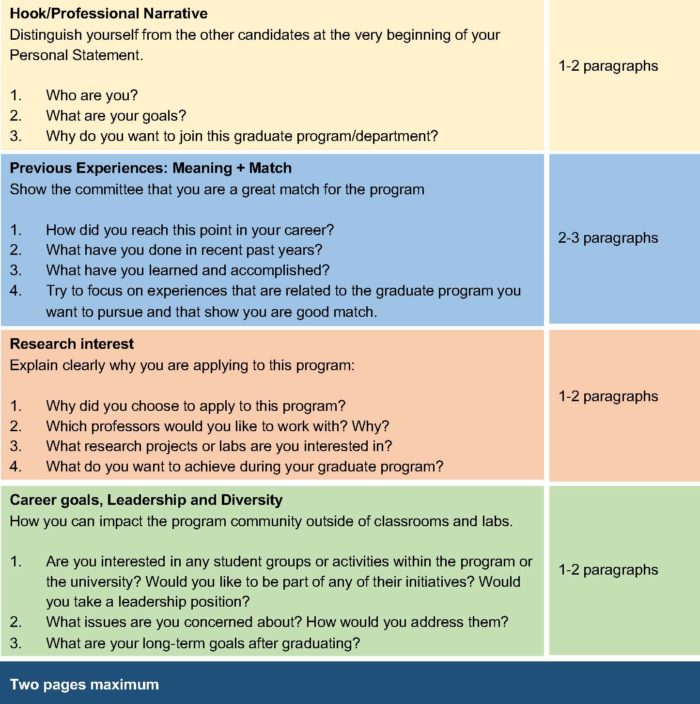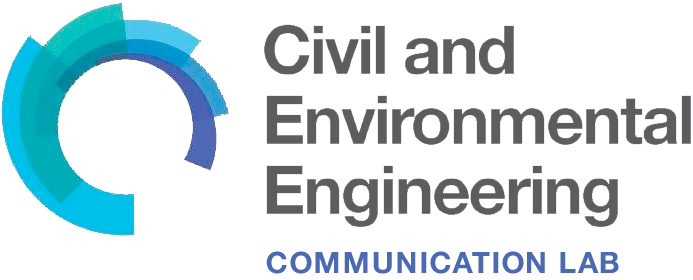Most recent revision of this article was led by Ignacio Martin Arzuaga Garcia.
Criteria for Success
- Focus on the aim. Convince a faculty committee that you are qualified for their program.
- Customize it. Show the admission committee that you are a good fit for the particular program you are applying for.
- Stand out. Highlight your skills and experiences that convey your strengths and differentiate you from other candidates.
- Be precise. Focus on concrete and quantitative examples.
- Be concise. Your Statement of Purpose should be no more than 2 pages. The MIT CEE graduate program recommends 1 – 1.5 pages.
Structure Diagram

Purpose
The graduate school Statement of Purpose is a document that complements your resume and application form, describing your profile in a narrative way and convincing the admission committee that you would be a good match for a particular department or program. Take into account that matching goes both ways: they should be interested in you, and you should be interested in them. Your Statement of Purpose should make this match clear.
Analyze Your Audience
Your Statement of Purpose will be read by a graduate committee – a handful of faculty from the program. They’re trying to determine if you will be a successful graduate student in their department and a successful scientist after you graduate. They are interested in your qualifications as a researcher, your career goals, and how your personality matches their labs and department.
The graduate committee probably reads hundreds of applications every year. To make it easy for them to figure out that you are a good fit, consider the following suggestions:
- Make direct, concrete statements about your accomplishments and qualifications.
- Create a narrative that serves as a personal brand and helps them remember you.
- Give them some unique examples that describe you and make you stand out, and which will make them remember you as “that candidate that was so passionate about…’ or “who has lot of experience in…”, although they might not remember your name.
Skills
Create a narrative
PhD programs invest in the professional and scientific growth of their students. Get the committee excited about investing in you by opening your essay with a brief portrait of what drives you as a scientist. What research directions are you passionate about, and why? What do you picture yourself doing in 10 years?
Close your essay with a 2-3 sentence discussion of your long-term career interests. No one will hold you to this; this just helps your committee visualize your potential trajectory.
Describe your experiences
Experiences are the “what” of your essay. They are the most efficient and easiest way to prove your capabilities to the admissions committee.
- What experiences led you to develop your skill set and passions?
- Where have you demonstrated accomplishment, leadership, and collaboration?
- Include research, teaching, relevant extracurriculars and leadership positions.
- State concrete achievements and outcomes like awards, discoveries, or publications, or projects completed.
Achievements are not limited to research projects or publications. You can discuss, for example, a research-oriented class project in which you stood out, and that is related to the type of work you expect in graduate school. Think about experiences demonstrate your ability to conduct research.
Quantify your experiences to show concrete impact. How many people were on your team? How many protocols did you develop? How many people were in competition for an award? As a TA, how often did you meet with your students? Describe actions. Rather than share how important the company was or how renowned the professor you worked with is, always direct the message to highlight your performance, which may include both independent and collaborative work.
| Vague experience | Concrete experience |
| As a senior, I received an A in a graduate-level Structure Mechanics course. | My interest in structural analysis led me to take advanced coursework to learn more about Steel structures. At the graduate-level Structural Mechanics course, I learned about joints design which boosted my interest in… |
| During my third year, I worked on a project for my Hydrology class that made me get interested in numerical modelling. | During my third year, I had the chance to conduct a research-oriented class project about the hydrology of the Mississippi river and the impact of global warming in its regime. In this project, I ran a hydrological numerical model using the open source software … While working in this project, I faced with the difficulty of getting updated topographic data of the study area. I managed to overcome this issue by… |
| I volunteered at the Career Fair for the last three years. At this position, I demonstrated my leadership and management skills. | Committed to being a great ambassador of our class, I volunteered at the Career Fair for last three years, welcoming the companies’ representatives, guiding them to their locations, and helping them assemble their booths. This experience allowed me to gain training on dealing with time constraints and a large group of people. Last year, for example…. |
Demonstrate a match to the program
A key point on writing your Statement of Purpose is to demonstrate that you have done previous research about the program to which you’re applying, that you understand its characteristics and objectives, and that you are really interested in joining it and willing to do your best to be successful in it. To do this:
- Read the program’s website. Learn about its faculty members and the projects they are working on. Check what topics and high level goals the department is committed to. Identify the main research areas.
- Get in contact with faculty and students in your target program. If you have had a positive discussion with someone at the department, you can include in your essay how those interactions confirmed that you would be a good match for the program.
State which professors in the program you would be interested in working with. Show how their research areas align with your background and your goals. You can even describe potential research directions or projects.
“Statement of Purpose” vs. “Personal Statement”
Many schools distinguish between the Statement of Purpose/Objective and the Personal Statement, providing different writing prompts for each. The main difference between these two types of essays is that the Statement of Purpose focuses on your professional background, goals and research interests, while the Personal Statement is more about your personal history and where your motivation for graduate school comes from.
| Statement of Purpose | Personal Statement | |
| Focus |
|
|
